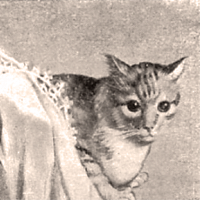This is a technique that I'm sure we will revisit many times here. Elisa Ricci has an entire chapter dedicated to it in her book Old Italian Lace (1913) which can be downloaded in pdf format from the Online Digital Documents Archive. In that book there are many incredible works pictured, some very old. This painting by Jean Clouet circa 1555 shows that Reticello was already perfected and well known outside of Italy (this is a portrait of the Duchess Claude of Lorraine, daughter of Catherine de' Medici) by the mid 16th century:

This unfinished 16th century piece of Reticello shows the various stages of its working:

Here is a beautiful piece from the Collezioni Comunali d'Arte museum in Bologna:


Like all needlework, Reticello has evolved over time. Today, with less and less time dedicated to embroidery, the designs have become simpler and less time-consuming but no less beautiful.
I want to show you two books by Giuliana Buonpadre, an Italian lady from Verona who has a small shop in Via S. Egidio in which she teaches needlework. On her website you can browse her books, clicking on the cover of Vol. 3, Il Reticello will get you a look at what a typical page looks like. Her books come in three languages, Italian, French and English and I like them a lot because she shows you clearly what to do and what the work will look like once it's done.
She does some amazing work. In her second book on Reticello (Volume 5), she has taken it to a new level. She has added colour to what is traditionally a whitework technique. This is a scan of the cover art on the book Fior di Reticello:

Not only has she added colour, she continues the design outside of the grid. I love the style of these designs even if I'm usually a traditionalist. There are many exquisite coloured pieces in this book, but also lots of traditional white ones as well. I believe that you can get Giuliana Buonpadre's books from the Drawn Thread in the US.
Next time we'll talk about books on a more traditional style of Reticello.
Different Styles of Reticello - Part Two
Different Styles of Reticello - Part Three
Different Styles of Reticello - Part Four
Different Styles of Reticello - Part Three
Different Styles of Reticello - Part Four





Hello,
ReplyDeleteI found your website today and it is incredible! It's going straight into my favorites folder.
Keep up the astounding work.
Victoria
Thank you Victoria!
ReplyDelete:-D
Dear Jeanine,
ReplyDeleteThank you very much for your website, it is very interesting. I am an embroidery teacher in france and I am looking for informations regarding Reticello. I have learned this technique in Roma with a fantastic teacher, but I need to know more history about This. When I was learning the different stitches, she told me that Michellangelo used to draw for the embroiderers. Do you confirm this information. And also, do you know where this technique is born ?
Tank you very much for your help.
Best regards
Elisabeth
elisabeth.roulleau@orange.fr
Elisabeth,
ReplyDeleteMany artists drew patterns for embroiderers so it is entirely possible that Michelangelo did too. There is some historical info on Reticello at: www.tuttoricamo.com look under "Techniques" for the article "Reticello: An Example of the Evolutionary Journey" by Laura Marzorati.
Dear Jeanine,
ReplyDeleteThank you for your website. I have become very intrigued with the embroidery work on a show called "Game of Thrones" I just began my quest for the tools to achieve artistic designs. Thank you for your blog!!!!
All my gratitude,
Dana
Hermoso,gracias por Compartir
ReplyDelete